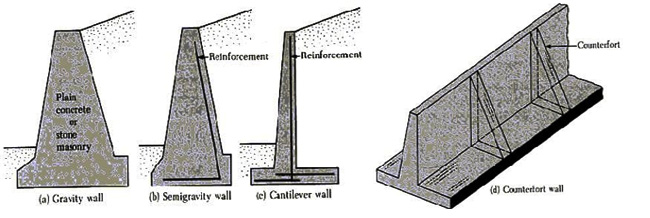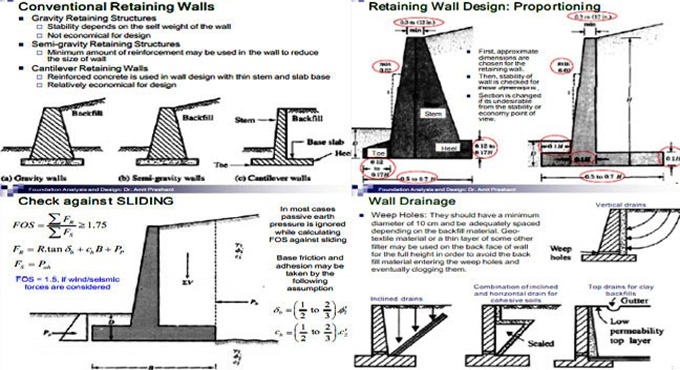NEWS | SOFTWARE | SHEET
Design and Uses of Cantilever Retaining Walls
The cantilever retaining wall helps to provide structural stability to the structure of the construction and prevent the risks of soil erosion. The long-term durability of the construction structure has been ensured by the use of the cantilever retaining wall in the building structure. The reinforced concrete used in the cantilever retaining wall helps to balance the pressure of the soil on the structure of the construction.

In addition, the reinforced concrete design of the cantilever retaining wall also helps to achieve the long-term strength of the building structure. In the cantilever retaining wall, a horizontal base slab and a vertical stem have been used, which helps to form the L-shape or the T-shape of the cantilever retaining wall. The cantilever retaining wall has been applied at various spaces, including basements, highways, and also in landscaping projects. The installation of the cantilever retaining wall is also cost-effective.
Key effectiveness of the cantilever retaining wall
There are several functions of the cantilever retaining wall, which are as follows:
- In the case of the sloped areas, the cantilever retaining wall helps to hold back the soil. Thus, the cantilever retaining wall helps to prevent the risks of landslides, as well as maintain land contours.
- The displacement of the soil has been minimised by using the cantilever retaining wall in the construction structure, which prevents the risks of soil erosion. As a result, the use of the cantilever retaining wall is ideal for gardens, urban development projects and roads.
- The cantilever retaining wall helps to distribute the forces that have been exerted through the retained soil, thus the cantilever retaining wall helps to prevent the structural failure of the construction structure.
- The cantilever retaining wall also incorporates the drainage pipes, which help to release the trapped water. Thus, the cantilever retaining wall reduces the hydrostatic pressure.
- In the construction of the cantilever retaining wall, less concrete is required as compared to the gravity walls, which is a cost-effective solution for construction projects.
Cantilever retaining wall design procedure
The main components for designing the cantilever retaining wall are as follows:
Stem
The stems are the vertical portion of the cantilever retaining wall, which helps to retain the soil.
Base slab
The base slab of the cantilever retaining wall has been divided into the heels and the toe.
Counterforts
This part of the reinforced concrete in the cantilever retaining wall helps to add supports to strengthen the tall walls.
Drainage system
The cantilever retaining wall includes a weep hole, which helps to prevent the accumulation of water behind the retaining wall and thus prevents the hydrostatic pressure on the wall.
Different types of cantilever retaining walls
Different types of cantilever retaining walls have different applications in construction projects, which are as follows:
Reinforced Concrete Cantilever Walls
The reinforced concrete cantilever wall has been built with the help of reinforced concrete along with the vertical stem and a horizontal base slab. In the case of the construction of a large-scale retaining structure, the reinforced concrete cantilever wall can be the best option. The design and reinforcement procedures should be done very carefully during the construction of the reinforced concrete cantilever wall, which helps to handle the high soil pressure.
Precast Cantilever Walls
These types of cantilever retaining walls have been manufactured off-site, and after that, these walls have been transported to the construction site for the installation procedure. In the case of the construction structure, which requires quick construction, for example, urban development projects, these types of cantilever retaining walls are appropriate.
The advantage of using the precast cantilever wall is, it helps to reduce the requirement of labourers, and also minimises the on-site curing time. Thus, the installation of the precast retaining walls can be a cost-effective solution for the team members of the construction projects.
Hybrid Cantilever Systems
These types of cantilever retaining walls have been designed for handling extreme loads. The hybrid cantilever system has been used in geotechnical projects, in which the soil conditions require additional stability measures. The hybrid cantilever system helps to provide high flexibility to the construction structure.
Discuss the cantilever wall failure
The cantilever wall failure can occur due to the influence of several factors, which are:
- The presence of the groundwater behind the cantilever wall sometimes has an adverse effect on the design of the cantilever wall, which can also affect the stability of the wall.
- The slip circle failure of the cantilever wall can also occur in the case of encountering the wall in clay soils.
- In the case of using low-quality material in the construction process of the cantilever wall can also lead to the cantilever wall's failure.
- The low design reinforcement also leads to the cantilever wall failure.
- In the case of errors in the calculation of the height of the water table or the wrong assumption about the soil type also leads to the risks of cantilever wall failure.


